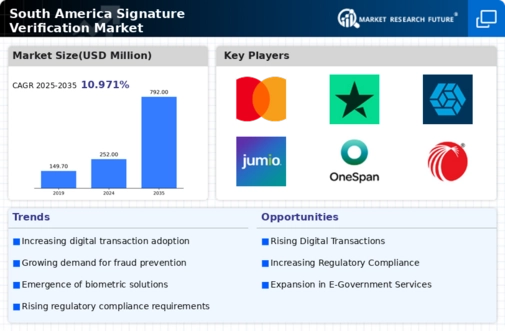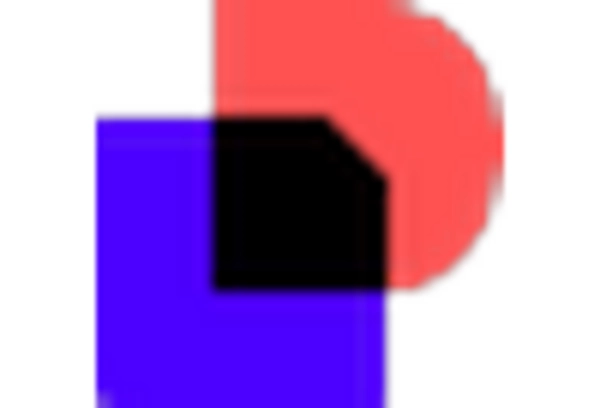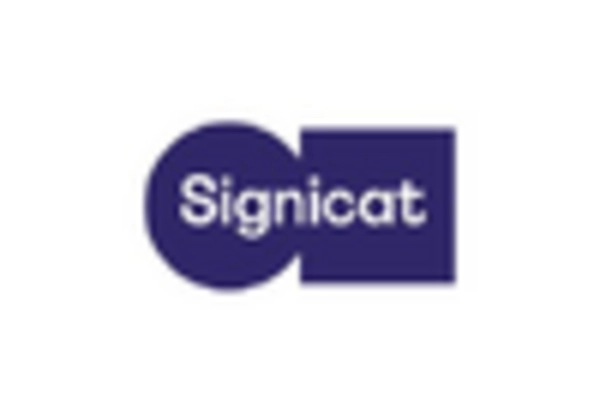Rising Cybersecurity Concerns
The increasing prevalence of cyber threats in South America has heightened the demand for robust security measures, particularly in the signature verification market. Organizations are increasingly recognizing the vulnerabilities associated with traditional signature methods, which are often susceptible to forgery and fraud. As a result, there is a growing inclination towards adopting advanced signature verification technologies that utilize biometric and digital solutions. According to recent data, the cybersecurity market in South America is projected to grow at a CAGR of 12% from 2025 to 2030, indicating a strong correlation with the rising need for secure signature verification systems. This trend suggests that businesses are prioritizing the protection of sensitive information, thereby driving the growth of the signature verification market.
Growing Demand for Remote Work Solutions
The shift towards remote work in South America has created a heightened demand for efficient signature verification solutions. As businesses adapt to flexible work environments, the need for secure and convenient methods to sign documents remotely has become paramount. This trend is particularly relevant in sectors such as finance, legal, and real estate, where timely document execution is critical. The signature verification market is likely to see increased investment in technologies that facilitate remote signing processes, ensuring compliance and security. With a significant portion of the workforce continuing to operate remotely, the market for signature verification solutions is expected to expand, driven by the necessity for seamless and secure digital workflows.
Expansion of E-commerce and Digital Transactions
The rapid expansion of e-commerce and digital transactions in South America is significantly influencing the signature verification market. As online shopping becomes increasingly prevalent, the need for secure transaction methods has surged. Consumers and businesses alike are seeking reliable ways to authenticate signatures in digital contracts and agreements. The e-commerce sector in South America is expected to reach $100 billion by 2025, which underscores the necessity for effective signature verification solutions. This growth presents a substantial opportunity for companies specializing in signature verification technologies, as they can cater to the rising demand for secure online transactions. Consequently, the signature verification market is likely to experience robust growth driven by the digital transformation of commerce.
Government Initiatives for Digital Transformation
Governments across South America are actively promoting digital transformation initiatives, which are expected to bolster the signature verification market. Various countries are implementing policies aimed at enhancing digital infrastructure and encouraging the adoption of electronic signatures in public and private sectors. For instance, Brazil's digital government strategy aims to streamline processes and improve efficiency, which includes the integration of secure signature verification systems. Such initiatives not only facilitate smoother transactions but also enhance trust in digital interactions. As governments invest in technology to modernize their services, the signature verification market is poised to benefit from increased adoption and regulatory support, potentially leading to a more standardized approach to digital signatures.
Technological Advancements in Signature Verification
Technological advancements are playing a crucial role in shaping the signature verification market in South America. Innovations such as artificial intelligence, machine learning, and blockchain technology are enhancing the accuracy and reliability of signature verification systems. These technologies enable organizations to detect fraudulent signatures more effectively and streamline the verification process. As businesses seek to improve operational efficiency and reduce risks associated with signature fraud, the adoption of these advanced technologies is likely to increase. The signature verification market is expected to benefit from ongoing research and development efforts, which may lead to the introduction of more sophisticated solutions that cater to the evolving needs of various sectors.


















Leave a Comment